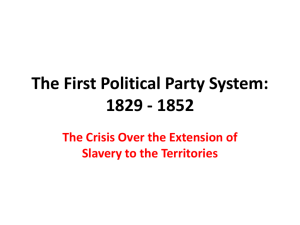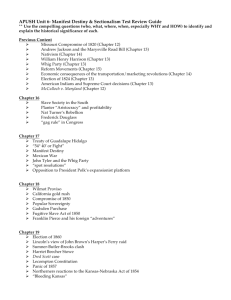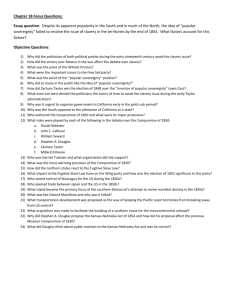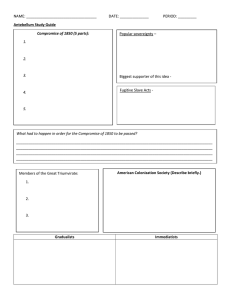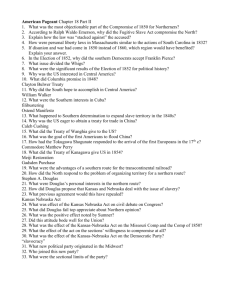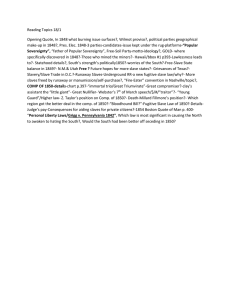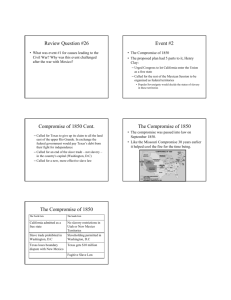Handout for Topic 4 (Part 3, PowerPoint)
advertisement
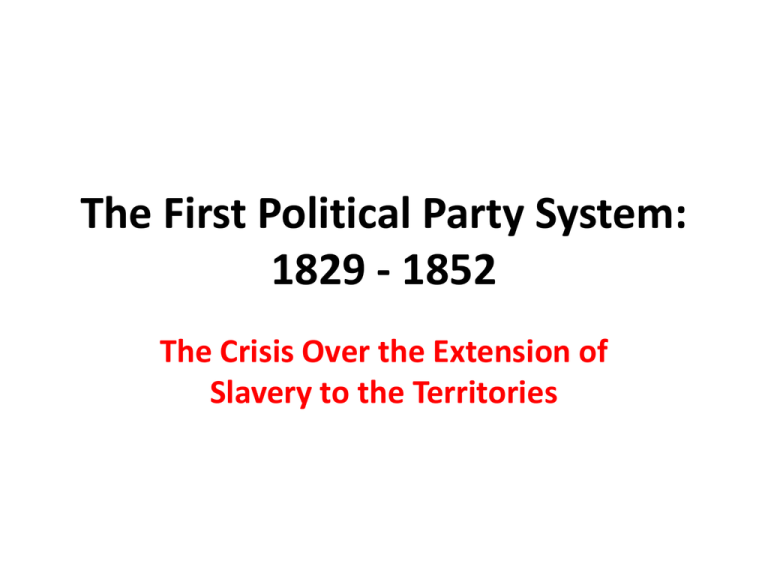
The First Political Party System: 1829 - 1852 The Crisis Over the Extension of Slavery to the Territories The War with Mexico -- 13 May 1846 to 13 January 1847 THE COMPROMISE OF 1850 a.California to be Admitted as a Free State – 24 January 1848 Gold Discovered in California at Sutter’s Mill. b. Part of Texas Given to the New Mexico Territory in exchange for the U.S. assuming its public debt. c. The Slave Trade was Abolished in the District of Columbia. d. A Fugitive Slave Law. e. Utah and New Mexico Were Organized as Territories – Popular Sovereignty. The Compromise of 1850 – Passed by a Coalition of Northern and Southern Democrats + Southern Whigs. Northern Whigs either opposed or abstained in the voting. Key Supporters: Henry Clay (Whig-KY), Stephen A. Douglas (Dem-IL), Daniel Webster (Whig-MA), Millard Fillmore (Whig, Vice-President and President as of 9 July 1850). Opposed, Zachary Taylor (Whig), President (died, 9 July 1850), Jefferson Davis (Dem-MS), William Seward (Whig/Free Soil-NY), Salmon P. Chase (Free Soil-OH), Charles Sumner (Free Soil-MA), John C. Calhoun (Dem-SC) – Made speech against and shortly thereafter died, 31 March 1850 (Vice President under John Quincy Adams and Andrew Jackson’s first term). The Publication of Uncle Tom's Cabin in 1852. Written by Harriet Beecher Stowe, it sold 300,000 copies during its first year of publication. It was turned into a stage play that was performed throughout the North. It helped fuel Northern Resistance to the Fugitive Slave Law. Stephen A. Douglas and the Kansas-Nebraska Act of 30 May 1854. The Kansas-Nebraska Act Repealed the Missouri Compromise of 1820 and declared "that all questions pertaining to slavery in the territories, and in the new States to be formed there from, are to be left to the people residing therein, through their appropriate representatives." It organized the Kansas and Nebraska Territories. Stephen A. Douglas, 23 April 1813 – 3 June 1861 1850 Map of the Proposed Route of the Illinois Central Railroad Illinois Central Railroad Preston (Bully) Brooks' Attack on Charles Sumner on the Senate Floor on 22 May 1856 after Sumner's two day speech "The Crime Against Kansas." 5 August 1819 – 27 January 1857 Charles Sumner, 6 January 1811 – 11 March 1874 Dred Scott, c. 1795 – 17 September 1858 SS Central America, sunk in a hurricane, 12 September 1857 Some of the Gold recovered from the wreck in 1987 John Brown, 9 May 1800 - 2 December 1859 "Now, if it is deemed necessary that I should forfeit my life for the furtherance of the ends of justice, and mingle my blood further with the blood of my children and with the blood of millions in this slave country whose rights are disregarded by wicked, cruel, and unjust enactments, I say, let it be done." (Speech from scaffold, 2 December 1859) Douglas 12 Lincoln 180 Breckinridge 72 Bell 39 (Fusion) 0 1,004,042 1,855,276 672,601 590,980 553,570 21.47% 39.67% 14.38% 12.64% 11.84% Northern Democrat Republican Southern Democrat Unionist Misc. Fusion Tick. A. SUMMARY – Realignment of the 1850s 1. Breadth and Depth of the Underlying Grievance – Slavery, it was moral and produced conflict for decades. 2. Capacity to Provoke Resistance – Self-Evident, War broke out. 3. Leadership – Douglas, Clay, and other leaders were unable to stop the polarization. 4. Division of Polar Forces Between the Two Parties – Split both Parties along North-South lines but the split in the Whig Party was deeper. 5. Strength of Existing Party Attachments – Strong, but overwhelmed by the Territorial Expansion Issue. The attachments held up well until the early 1850s. SUMMARY – Realignment of the 1850s -- The Realignment Scenario Clearly Type 4 -- Realignment in which One Party is Replaced. The System evolves from State A to State E.
